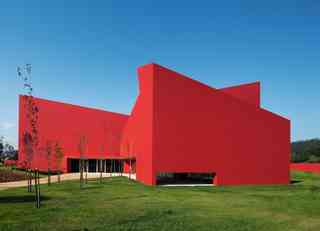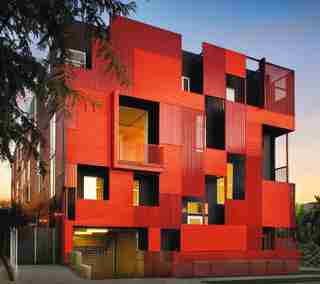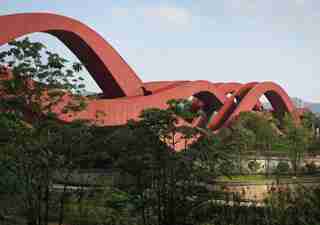The color red carries many meanings—it represents power, love, anger, beauty, fire, and energy, among other things. It is the color of the holiday season, and it serves as a symbol of good luck in Asia. Prehistoric artists used it for cave paintings, and it is still beloved by artists today. In the ‘80s, Keith Haring said of the color, “Red is one of the strongest colors; it’s blood, it has a power with the eye. That’s why traffic lights are red I guess, and stop signs as well . . . In fact I use red in all of my paintings.” In architecture, red is arresting—against a sea of glass skyscrapers and dull facades, a bright monochromatic structure will stop you dead in your tracks. In a new book from Phaidon , out now, titled Red: Architecture in Monochrome, the publisher amasses a collection of over 150 examples of the color in action, designed by the likes of Studio KO, Jean Nouvel, Philip Johnson, and Daniel Libeskind, and other prominent architects. Ahead, take a look at some of the most groundbreaking and inventive structures clad in red around the world.

Casa das Artes, Future Architecture Thinking
Miranda do Corvo, Portugal.

Formosa 1140, LOHA Architects
Los Angeles

Lucky Knot, NEXT Architects
Changsha Meixi Lake District, China
Barcode, Vitruvius and Sons
St. Petersburg, Russia.
10Cal Tower, Supermachine Studio
Bang Saen Beach, Thailand.
Flex-Red, Cerejeira Fontes Architects
Gualtar, Portugal
Nuestra Señora del Carmen Neuropsychiatric Center, José Javier Gallardo
Zaragoza, Spain.
Center for Jewish Life at Drexel University, Stanley Saitowitz/Natoma Architects.
Philadelphia
Paperbridge, Steve Messam
Lake District, England
The Muddus Block, Wingårdhs Architectural Office
Stockholm
Red: Architecture in Monochrome .
Published by Phaidon; $49.95.
